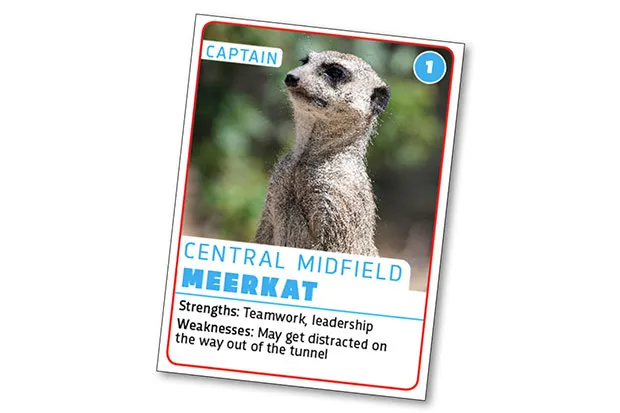Meerkat (Captain) - Central Midfield

Harry Kane had better watch out – female meerkats are the animal kingdom’s ultimate team leaders. Matriarchal mobs form around an alpha female who directs the pack when it’s threatened. As excellent sentinels, they’d always have a watchful eye on what’s going on in the game, communicating through barks when opposition is on the attack. Meerkats live in large societies, so they’ve got teamwork nailed.
Mantis shrimp - Goalkeeper

To get the ball out of the box at speed, you need a mantis shrimp. The peacock mantis shrimp seen here might only be 10cm long, but with its specialised ‘clubs’ it can punch through water with enough force to cause an explosion. Let’s see Jordan Pickford do that. But there might be a few issues: some species use their sharp forelimbs to stab prey, and we’re not sure what rules FIFA has for punctured balls.
Honey badger - Centreback

For aggression, recruit the honey badger. You’re guaranteed a no-mercy defender that won’t be lost to injury. Its skin can withstand multiple blows from a machete – long enough for the ref to blow the whistle and cart that machete-wielding maniac off the pitch. The honey badger has some wrestling moves that Sergio Ramos would be proud of. He’s a prime candidate for red cards, but he’ll do some damage first.
Dragonfly - Wingback

Even the niftiest attackers will struggle to outwit the dragonfly. It has up to 30,000 facets on each eye, which give it 360° sight, while four wings mean it can move forwards, backwards, sideways, up and down without changing orientation. What’s more, dragonflies don’t react to prey moving; they predict their prey’s movements before they even occur. Good luck dribbling round one of these creatures.
Prong-horned antelope - Winger

Footballers need to be nippy on their feet, but also have to possess enough endurance to last the full 90 minutes of a game. Neymar’s got some legs on him (even though at times this year he's struggled to stay on them), but even he’d look a little sluggish up against a prong-horned antelope. These four-legged beasts can maintain a speed faster thanUsain Boltfor about an hour, and will keep on going at a fair old pace after that – useful if the game goes to extra time.
Kangaroo - Striker

When it comes to pure firepower, the red kangaroo can’t put a foot wrong. Australians aren’t usually known for their football prowess, but this native can balance on its tail and use both feet to kick with net-ripping force. Ronaldo’s kick can shatter glass from 20m out, but one swift boot from a red kangaroo can break bones. They punch hard too, so let’s make sure any kangaroos we field can keep their tempers under control.
This article first appeared inissue 324ofBBC Focusmagazine –check out the latest subscription deals here.
Follow Science Focus onTwitter,Facebook, Instagramand Flipboard
